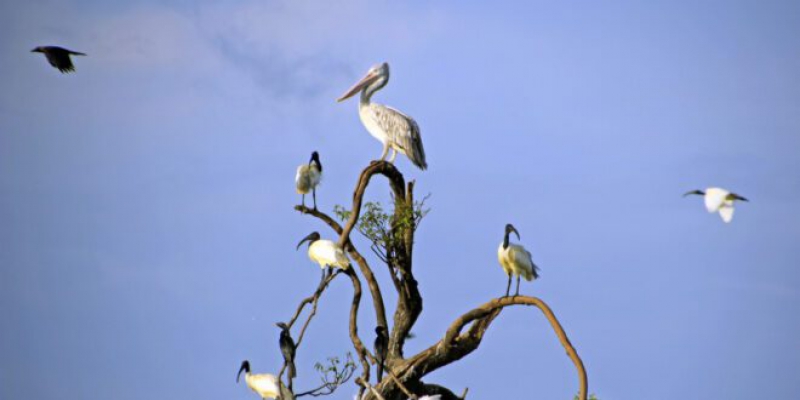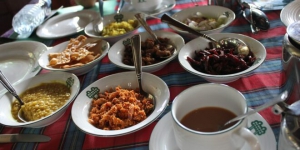Animals and Plants in Sri Lanka
Sri Lanka is a tropical island with wild animals, rainforest and beaches. But what does the landscape actually look like in detail? Round trips pass many different ecocultures in a small area: Large parts of the country are characterized by steppe-like dry areas with large lakes and bushland, there are wetlands along the mighty rivers, and mangrove forests, sand dunes and beaches alternate around the island near the coast.
Plants and vegetation: What grows in Sri Lanka's nature?
If you travel from east to west, you will find changed natural environments: In the north and east, dry plants live in bush vegetation. In the southern and western parts it is wetter and the vegetation is correspondingly more lush. Mountain cloud forests grow in Hortons Plains National Park, for example, and lowland rainforest grows in Sinharaja National Park.
20% of Sri Lanka's area is covered by forests, but only a fraction of it is tropical rainforest. Especially in the lower wetlands, e.g. in the Sinharaja Protected Area, an almost unbelievable biopersity grows and thrives in addition to valuable tropical woods such as teak and ironwood, which can be explored on rainforest hikes.
In the middle altitudes of Sri Lanka, spice plants such as cinnamon trees and cardamom bushes as well as tea plantations thrive around Nuwara Eliya.
The highlands, on the other hand, are characterized by mystical-looking mountain cloud forest. The high humidity is ideal for epiphytes such as lichens, mosses and orchids, and ancient tree ferns also find the best growing conditions here.
Sri Lanka's wildlife
Sri Lanka is one of the biopersity hotspots in Asia due to its perse nature. The numerous national parks are home to monitor lizards, crocodiles, giant snakes such as the tiger python, various monkeys such as hat monkeys, Hanuman langurs and white-bearded langurs as well as sambars, axis deer and wild boar, water buffalo, geckos and parrots, but also unknown animals such as the endemic Ceylon spotted deer, Sri Lankan giant squirrel, Ceylon kanchil, the gray slender lorikeet or the Indian pangolin. Some species representatives are only native to Sri Lanka and are the destination of most national park safaris.
The sloth bear :
The forests of lowland protected areas such as Wilpattu and Yala are home to the rare and shy sloth bears – one of the animal highlights in Sri Lanka. They are about 60-90 cm high, have black fur that is somewhat shaggy in the neck area, a long, hairless snout and feed on insects. They are mainly active at night, but with a bit of luck they can also be spotted outside their hiding places in the dense vegetation during the day.
The leopard :
Another rare animal that is on the list of many photo tourists is the Sri Lankan leopard, which inhabits the humid areas of the national parks as a habitat and is found in about 500 specimens in Sri Lanka. Yala National Park, for example, is one of Asia's hotspots as far as the shy big cat is concerned, but it also lives in the tropical rainforest, as well as in steppes and savannahs, such as Wilpattu National Park, Gal Oya National Park, Maduru Oya National Park, Udawalawe National Park and Minneriya National Park.
The elephant :
Sri Lanka's endemic elephant, the Sri Lankan elephant or Ceylon elephant, is also striking for Sri Lanka's wildlife, which is not only common in some national parks. In some places it occurs in such a delicately large number of herds that one can study family structures and social behavior. The waterholes of Minneriya National Park are famous for this, where they linger for a long time instead of passing by. This park is on the hiking route with Kaudulla National Park and Hurulu Eco Park – the Sri Lankan elephant passes through all three.
From the shore of the Uda Walawe Reservoir in the Udawalawe National Park, you can watch the bathing animals and the Elephant Transit Home is also nearby. In Gal Oya National Park, there are many islands in the reservoir between which elephants swim back and forth.
Note on elephant facilities in Asia : There are many idyllic pictures of bathing baby elephants and feeding offers for tourists. Be careful, cruel means such as chaining and elephant hooks are often used here. The tricks performed are strongly forced, the points used for dressage. It is unclear whether "orphanages" are always real young animals left behind or simply captive animals.
If you want to see Asian elephants without fences and bars, you can go on an elephant safari or go to the Elephant Transit Home in Udawalawe, where elephants are prepared for release into the wild after they have been successfully nursed back to health. Chains, beatings and forced contact with people are taboo here. The "Elephant Orphanage" Pinnawela gets very bad reviews from various sources for exactly these reasons.








